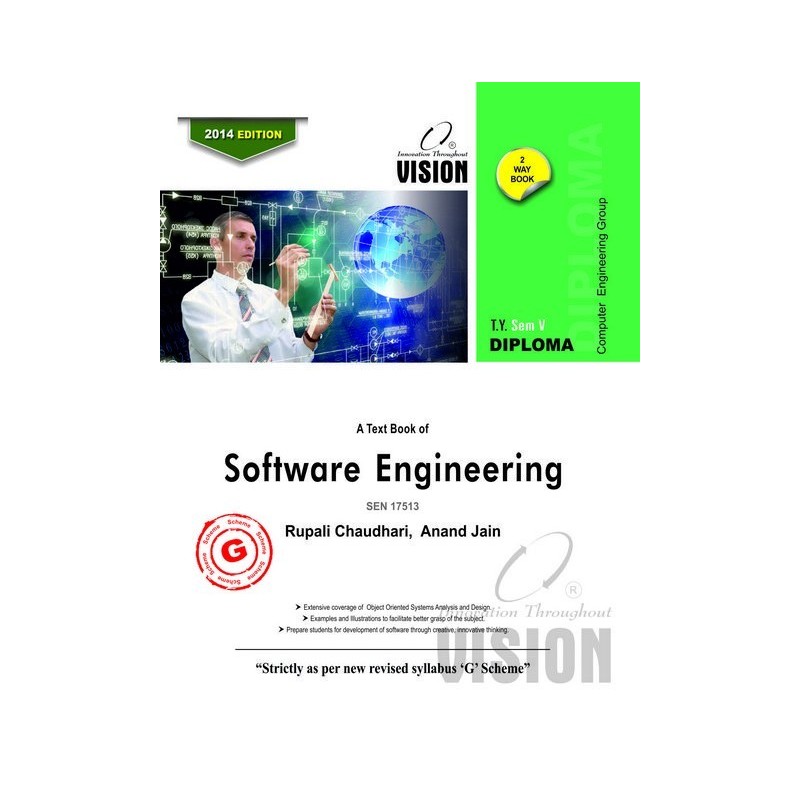Email: tovisionpune@gmail.com



Author: Rupali Choudhari and Anand JAin
Book ID: 1579
ISBN: 978-93-5016-250-7
Contents
1. Overview of Software Engineering and the Software Development Process
1. Introduction to SE
2. Evolving Role of Software and Changing Nature of Software
2.1 Definition of Software
2.2 Characteristics of a Software
2.3 Categories of Software
3. Software Engineering a Layered Technology Approach
3.1 Definition of Software Engineering
3.2 Need of Software Engineering
3.3 Software Engineering as a Layered Technology
4. Software Development Process (Process Framework)
4.1 Generic Process Framework Activities
4.2 Umbrella Activities
5. The Capability Maturity Model Integration Technique (CMMI)
6. PSP AND TSP (Personal and Team Software Process Models)
6.1 PSP (Personal Software Process)
6.2 TSP (Team Software Process)
7. Prescriptive Process Models
7.1 The Waterfall Model
7.2 Incremental Process Model
7.3 The Rapid Application Development Model (RAD Model)
7.4 Prototyping Model
7.5 Spiral Model
8. Agile Software Development
8.1 Difference between Prescriptive and Agile Process Model
8.2 Features of Agile Software Development Approach
8.3 Concept of Extreme Programming
2. Software Engineering Practices and Software Requirements Engineering
1. Introduction
2. Software Engineering Practice
2.1 The Essence of Practice
3. Core Principles of Software Engineering
4. Communication Practices
5. Planning Practices
6. Modeling Practices
6.1 Requirements Analysis Modeling Principles
6.2 Design Modeling Principles
7. Construction Practices
7.1 Coding Principles
7.2 Testing Principles
8. Deployment Practices
9. Requirements Engineering (RE)
9.1 Need of Requirements Engineering (RE)
9.2 Requirements Engineering Tasks (RE Tasks)
10. Concepts of SRS
10.1 General Format of SRS
10.2 Need / Importance of SRS
10.3 Characteristics of a great SRS
3. Analysis and Design Modelling
1. Analysis Modeling
1.1 Objectives of Analysis Modeling
1.2 Analysis Rules of Thumb
1.3 Domain Analysis
1.4 Analysis Modeling Approaches
1.5 Elements of Analysis Models
2. Design Modeling
2.1 Importance of Software Design
2.2 Design Concepts
2.3 Elements of Design Modeling
2.4 Pattern Based Design
2.5 Rum Baugh Method for Object Oriented Design
4. Software Testing Strategies and Methods
1. Introduction
2. Software Testing Fundamentals
2.1 Definition of Software Testing
2.2 Successful Testing
2.3 What is a good test?
2.4 Test Documents
2.5 Characteristics/ Parameters of Testable Software
3. Software Verification and Validation
3.1 Verification
3.2 Validation
4. Testing Strategies
4.1 Unit Testing
4.2 Integration Testing
4.3 Validation Testing
4.4 System Testing
5. White-box and black-box Testing
5.1 White-Box Testing
5.2 Black-Box Testing
5.3 Difference between Black Box Testing and White Box Testing
6. Debugging
6.1 What is a Bug?
6.2 The Debugging Process
6.3 Debugging Strategies
5. Software Project Management
1. Introduction
2. Software Project Management (SPM)
2.1 Need of SPM
2.2 Project Management Functions
3. The Management Spectrum
3.1 The People
3.2 The Product
3.3 The Process
3.4 The Project
4. Project Scheduling and Tracking
4.1 Need
4.2 Project Scheduling
4.3 Project Scheduling Principles
4.4 Factors that Delay Project Scheduling
4.5 Project Scheduling Techniques
4.6 Tracking the Schedule
5. Concept of Task Network
6. Risk Management
6.1 Reactive Versus Proactive Risk Strategies
6.2 Types of Software Risks
6.3 Risk Projection
6.4 RMMM Strategy
7. Risk Assessment
8. Change Management
8.1 Need of SCM
8.2 SCM Scenario
8.3 SCM Repository
8.4 SCM Features
8.5 SCM Process
6. Software quality management
1. Introduction
2. Basic Quality Concepts
2.1 Definition of Software Quality
2.2 Quality Control
2.3 Quality Assurance (QA)
2.4 Cost of Quality
3. Software Quality Assurance (SQA)
3.1 Definition of SQA
3.2 SQA Activities/Tasks
3.3 Formal Technical Reviews (FTR’s)
4. Concept of Statistical SQA
5. Quality Evaluation for Software
5.1 Six Sigma Strategy for Software
5.2 Core Steps of the Six Sigma Methodology
6. ISO 9000 for Software
7. CMMI
7.1 CMMI Levels
7.2 CMMI Process Area
8. CMMI Vs ISO
9. Mc Call’s Quality Factors
9.1 Product Operation Factors
9.2 Product Revision Factors
9.3 Product Transition Factors